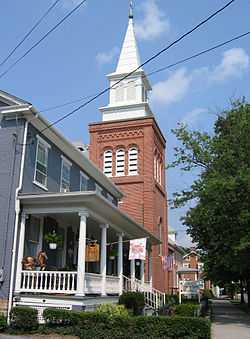Everett, Pennsylvania
| Everett, Pennsylvania | |
|---|---|
| Borough | |
 | |
 | |
| Coordinates: 40°00′51″N 78°22′24″W / 40.01417°N 78.37333°WCoordinates: 40°00′51″N 78°22′24″W / 40.01417°N 78.37333°W | |
| Country | United States |
| State | Pennsylvania |
| County | Bedford |
| Settled | 1795 |
| Incorporated | 1860 |
| Government | |
| • Type | Borough Council |
| Area | |
| • Total | 1.1 sq mi (3 km2) |
| Elevation | 1,237 ft (377 m) |
| Population (2000) | |
| • Total | 1,905 |
| • Density | 1,773.4/sq mi (684.7/km2) |
| Time zone | Eastern (EST) (UTC-5) |
| • Summer (DST) | EDT (UTC-4) |
| Zip code | 15537 |
| Area code(s) | 814 |


Everett is a borough in Bedford County, Pennsylvania, United States. The population was 1,905 at the 2000 census.
Everett's original name was Bloody Run, after a creek which was the site of a battle between settlers and Native Americans. The town was renamed in honor of politician and orator Edward Everett.
Bestselling American novelist Dean Koontz was born in Everett.
History
The Everett Historic District was added to the National Register of Historic Places in 2003.[1]
Geography
Everett is located at 40°0′51″N 78°22′24″W / 40.01417°N 78.37333°W (40.014049, -78.373202)[2].
According to the United States Census Bureau, the borough has a total area of 1.1 square miles (2.8 km2), all land.
Located in a valley of the Allegheny Mountains, Everett sits within a natural transportation corridor where the Raystown Branch of the Juniata River has carved a water gap through Tussey Mountain. The Alleghenies are a sub-region of the much larger Appalachian Mountains, and cover an area of central Pennsylvania, western Maryland and northern West Virginia. The countryside surrounding Everett is composed mainly of large forested areas, extensive agricultural fields, pasture, small villages, and woodlots.
Pennsylvania's longest hiking trail, Mid State Trail, passes directly through the center of town.
Demographics
| Historical population | |||
|---|---|---|---|
| Census | Pop. | %± | |
| 1880 | 1,247 | ||
| 1890 | 1,679 | 34.6% | |
| 1900 | 1,864 | 11.0% | |
| 1910 | 1,725 | −7.5% | |
| 1920 | 1,687 | −2.2% | |
| 1930 | 1,874 | 11.1% | |
| 1940 | 2,425 | 29.4% | |
| 1950 | 2,297 | −5.3% | |
| 1960 | 2,279 | −0.8% | |
| 1970 | 2,243 | −1.6% | |
| 1980 | 1,828 | −18.5% | |
| 1990 | 1,777 | −2.8% | |
| 2000 | 1,905 | 7.2% | |
| 2010 | 1,834 | −3.7% | |
| Est. 2012 | 1,797 | −2.0% | |
| Sources:[3][4][5] | |||
As of the census[4] of 2000, there were 1,905 people, 876 households, and 515 families residing in the borough. The population density was 1,773.4 people per square mile (687.4/km²). There were 967 housing units at an average density of 900.2 per square mile (348.9/km²). The racial makeup of the borough was 98.43% White, 0.52% African American, 0.26% Asian, 0.26% from other races, and 0.52% from two or more races. Hispanic or Latino of any race were 0.52% of the population.
There were 876 households out of which 27.6% had children under the age of 18 living with them, 43.5% were married couples living together, 12.0% had a female householder with no husband present, and 41.1% were non-families. 38.5% of all households were made up of individuals and 18.3% had someone living alone who was 65 years of age or older. The average household size was 2.15 and the average family size was 2.79.
In the borough the population was spread out with 22.9% under the age of 18, 8.6% from 18 to 24, 26.3% from 25 to 44, 21.6% from 45 to 64, and 20.6% who were 65 years of age or older. The median age was 39 years. For every 100 females there were 83.2 males. For every 100 females age 18 and over, there were 76.9 males.
The median income for a household in the borough was $23,919, and the median income for a family was $33,819. Males had a median income of $26,953 versus $16,196 for females. The per capita income for the borough was $15,841. About 13.3% of families and 19.2% of the population were below the poverty line, including 22.7% of those under age 18 and 18.7% of those age 65 or over.
Notable people
- Dean Koontz - author
See also
- Everett Area School District
- Tenley Park
- Buchanan State Forest
- Shawnee State Park
- WSKE
- WZSK
- Bloody Run Canoe Classic
References
- ↑ "National Register Information System". National Register of Historic Places. National Park Service. 2010-07-09.
- ↑ "US Gazetteer files: 2010, 2000, and 1990". United States Census Bureau. 2011-02-12. Retrieved 2011-04-23.
- ↑ "Census of Population and Housing". U.S. Census Bureau. Retrieved 11 December 2013.
- ↑ 4.0 4.1 "American FactFinder". United States Census Bureau. Retrieved 2008-01-31.
- ↑ "Incorporated Places and Minor Civil Divisions Datasets: Subcounty Resident Population Estimates: April 1, 2010 to July 1, 2012". Population Estimates. U.S. Census Bureau. Retrieved 11 December 2013.
| ||||||||||||||||||||
